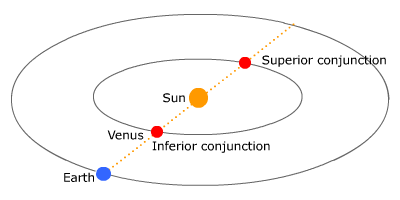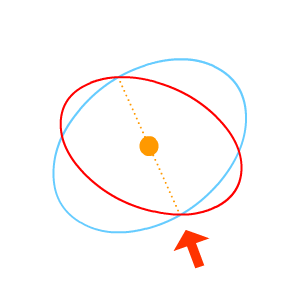Astronomy : Conjunctions
Venus is an inner planet (it is closer to the Sun than the Earth) and that is why it never reaches more than 47° from the Sun in the sky. If it is on the left with regard to the Sun, it is the case of western elongation. On the contrary, when it is on the right, it is the case of eastern elongation and so it can be seen before sunrise (which is why it is called the Morning Star).
The conjunction of Venus and the Sun occurs by crossing between the eastern and southern elongation. It is purely a geometrical situation, nothing extraordinary occurs in the solar system, simply the Sun, Venus and the Earth move in line (see the picture) and on Earth, Venus projects near the Sun (rarely straight into it, but we will discuss this later). The conjunction can occur in two cases:
- Venus is closest to the Earth, so it is exactly between the Sun and the Earth. Then it is the case of so-called inferior conjunction and Venus can be seen just as a thin sickle (the sunlight is falling on the reverse side). The inferior conjunction can lead to the appearance of Venus crossing over the Sun.
- Venus is furthest from the Earth, so it is behind the Sun. At this point the so-called superior conjunction occurs. In this case, the whole of Venus can be seen (we call it a full moon in the case of the Moon), because we see just the side of the planet, which is close to the Sun. The superior conjunction leads to the appearance of Venus 'hiding' behind the Sun.

Calculation of sideric period
It is possible to count how often the inferior conjunction of Venus and the Sun occurs:
Let's express the orbital speed of the Earth in the unit degree/day: Ve=360/365,25=0,98 degrees per day. (because in 365,25 days it travels the distance of 360 degrees.)
We know that Venus orbits the Sun in 224,7 days, so its orbital speed in our unit is Vv = 360/224,7 = 1,6 degrees per day.
Between individual conjunctions intervenes the time "t" days, in which Venus travels the orbit t*Vv degrees and the Earth t*Ve degrees. But one of the planets has to travel one more circuit, so that it draws level with the second one, so that the planets arrive in one straight line again. The faster planet evidently takes this circuit, thus Venus.
Now we put together the equation:
Vz*t+360 = Vv*t
(I add to the Earth's circuit 360 degrees, so that both sides of the equation are equal)We adapt the equation:
t = 360 / (Vv-Vz) t = 360 / (1,6-0,98) t = 584 days
Venus transit
With the inferior conjunction, Venus rarely arrives exactly on the connecting line Earth-Sun, because the orbits of these two planets are not in one plane (Venus' orbit deviates 3,4° from the orbit of the Earth). In order that the Venus transit occurs (as, for example, in 2004), the inferior conjunction must arise in proximity of Venus' and Earth's orbit node, so in the points where the orbit planes intersect. There are two such points, as can be found from the picture.

orbit nodes)
That is why the Venus transit over the Sun does not occur every 584 days but two transits occur always after 121,5 or 105,5 years. These two transits occur 8 years apart (eg. 2004 and 2012). So, we can observe another transit (it will be partly visible in the Czech Republic on the 6th June 2012) but the following one, in the year 2117, will unfortunately be a sight only for our children.
